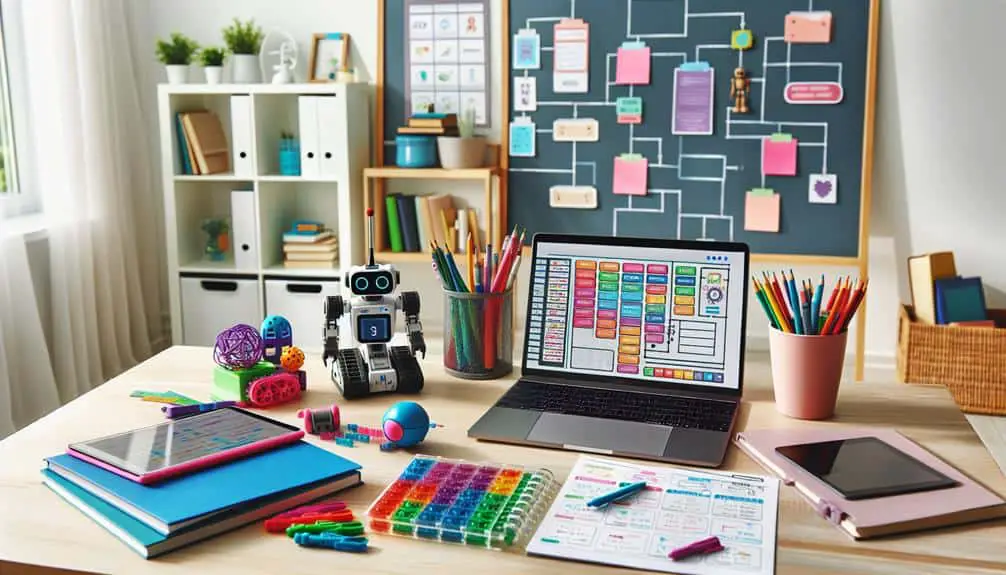Craft a tech-centric homeschool curriculum by tailoring it to your child's needs, leveraging personalized instruction, and customizing teaching methods. Engage with interactive learning platforms like Khan Academy and coding apps to enhance skills. Balance screen time with offline activities like outdoor exploration and hands-on projects to stimulate creativity. Regularly evaluate progress using quizzes and feedback mechanisms to guarantee effectiveness. Your child's educational journey will thrive with this innovative approach.
Key Points
- Tailor learning to child's style, pace, and interests for personalized instruction.
- Utilize interactive platforms like Khan Academy for engaging content.
- Balance screen time with offline activities for a holistic educational experience.
- Evaluate curriculum effectiveness through objective metrics and qualitative feedback.
- Align tech tools with learning needs and goals to enhance academic performance.
Understanding Homeschool Curriculum Needs
To design a tech-focused homeschool curriculum that truly meets your needs, understanding the specific requirements of your homeschooling journey is essential. Tailored learning and personalized instruction are key components that cater to your unique situation.
Tailored learning involves adapting the curriculum to fit your child's learning style, interests, and pace. This approach guarantees that your child remains engaged and motivated throughout their educational journey.
Personalized instruction goes hand in hand with tailored learning. It involves providing one-on-one guidance and support to address your child's strengths and weaknesses effectively. By customizing the teaching methods and materials, you can enhance your child's learning experience and overall academic performance.
Identifying Tech Tools and Resources
When designing a tech-focused homeschool curriculum, it's essential to identify cutting-edge tech tools and resources that align with your child's learning needs and goals. To guarantee tech literacy and access to valuable digital resources, consider the following:
- Interactive Learning Platforms: Platforms like Khan Academy, Coursera for Kids, or Prodigy can offer engaging content tailored to your child's interests and educational level, fostering tech skills while making learning fun.
- Coding Apps and Games: Introducing coding through apps like Scratch, Code.org, or coding games can enhance problem-solving abilities, logical thinking, and creativity, all vital aspects of tech literacy in today's digital world.
- Online Research Databases: Access to online research databases such as JSTOR, National Geographic Kids, or Britannica School can nurture critical thinking skills and provide reliable information, promoting digital literacy and research proficiency.
Incorporating Interactive Learning Platforms
Incorporate interactive learning platforms to engage your child effectively in tech-focused homeschooling, enhancing their digital skills and knowledge acquisition. Engaging simulations can provide a dynamic way for your child to grasp complex concepts.
Platforms like virtual labs or interactive storytelling tools offer hands-on experiences that make learning more immersive and enjoyable. Collaborative projects further enhance the interactive learning experience by fostering teamwork and communication skills.
Encourage your child to work with peers on group assignments using online platforms that allow real-time collaboration. These projects not only deepen understanding but also promote social interaction, critical for your child's holistic development.
Balancing Screen Time and Offline Activities
Consider the importance of balancing screen time and offline activities to ensure a well-rounded tech-focused homeschooling experience for your child. Finding the right equilibrium between digital and hands-on experiences is vital for their development. Here are some tips to help you achieve this balance:
- Outdoor Exploration: Encourage your child to spend time outdoors engaging with nature. Activities like gardening, nature walks, or simply playing outside can provide a revitalizing break from screens while promoting physical activity and appreciation for the environment.
- Creative Projects: Foster your child's creativity through offline projects. Arts and crafts, DIY science experiments, or building projects not only limit screen time but also stimulate imagination and problem-solving skills.
- Hands-On Learning: Incorporate hands-on learning experiences into your curriculum. Activities like cooking together, conducting science experiments, or playing educational board games can offer valuable learning opportunities away from screens, promoting a holistic educational experience for your child.
Evaluating Curriculum Effectiveness
To gauge the effectiveness of your tech-focused homeschool curriculum, regularly assess your child's progress through objective metrics and feedback mechanisms. Measuring outcomes is essential in tracking progress and ensuring your curriculum is meeting its intended goals.
Consider utilizing tools like online quizzes, standardized tests, and project assessments to quantitatively evaluate your child's understanding and development. Additionally, encourage open communication with your child to gather qualitative feedback on their engagement, challenges, and overall satisfaction with the curriculum.




